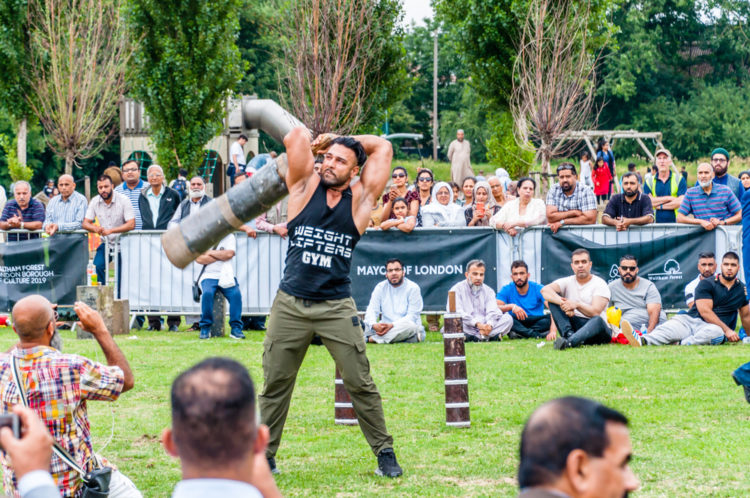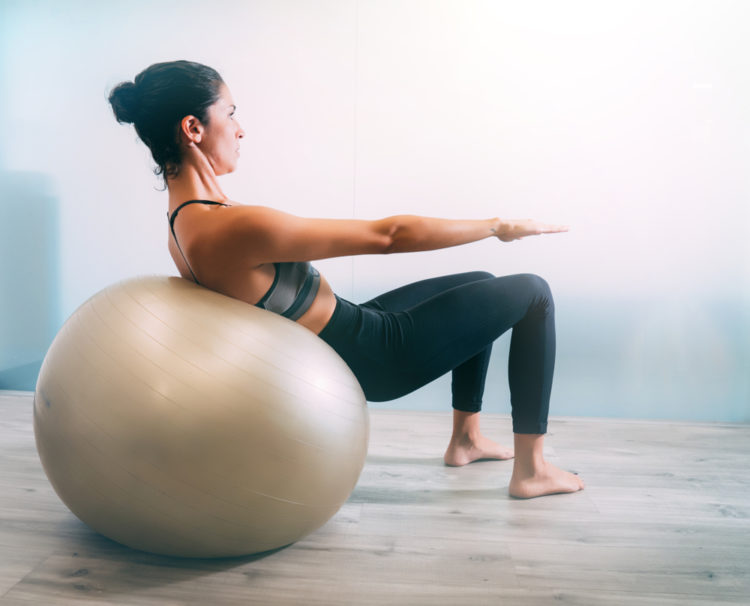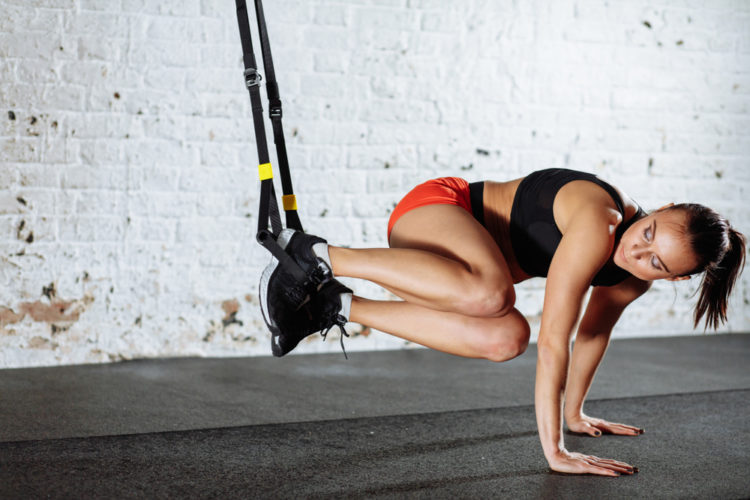This article will understand functional training in its simplest sense, that is, the ability to perform tasks in everyday life. This distinguishes functional training from powerlifting or bodybuilding, where lifting weights is linked to a specific end. Think then of functional training as a pseudo-medicinal approach to the gym rather than the more competitive styles found elsewhere. Functional training draws on other aspects of the lifting community but it is often a standalone field for those recovering from injury, those new to the gym, and oftentimes, professional athletes looking for a competitive edge.
As a term, ‘functional training’ emerged tentatively in the 1980s and 1990s before exploding into the fitness mainstream in the early noughties. Despite its relative novelty however, the idea that training could serve a medicinal purpose has long existed.
The clichéd image of a man squatting a barbell while he straddles a swiss ball has, for many, become synonymous with that nebulous phrase, ‘functional training.’ But that’s just a stereotype. Although derided by many, there is nevertheless a great value in functional training. When it is done correctly, functional training can help prevent injuries, increase strength and improve posture. That it can be used beneficially and detrimentally means that there is perhaps no other term in the fitness industry that is used, and abused, as much as ‘functional training.’
https://www.instagram.com/p/B1uEz5eHvmE/
Early Precursors to Functional Training
Previously on Barbend we discussed the practice of calisthenics and weightlifting in the Ancient World. It should come as no surprise, then, to learn that one of the first examples of functional training can be traced to Ancient Greece. Unlike the enormous feats of strength exhibited by Greek heroes, demi-gods and sportsmen, functional training was associated with everyday citizens. According to Jack Berryman, the physician Hippocrates would ask patients to toss balls to one another to relieve pain and illnesses.(1) It is for this reason that many nowadays credit Hippocrates with inventing the ‘medicine ball.’(2) It’s a nice story, but it is far more likely that Hippocrates was just one of many individuals advising this practice.
That the Ancient Greeks promoted this practise, including the famed Galen who came after Hippocrates, was significant.(3) Training and calisthenics after the fall of Greece in the seventh century largely became the preserve of soldiers and nobles while the average citizen was left to toil through life.(4) This situation changed during the sixteenth century in Europe when physicians began to take a much greater interest in antiquity. Illustrative of this was Girolamo Mercuriale’s De Arte Gymnastica, published in 1569, which reintroduced many of the Ancient’s ideas on health, strength and the body.(5) Considered by many as the first physical therapy book, De Arte rejuvenated the idea that physical training could be used as treatment.
In the wake of De Arte several more physicians began prescribing and playing around with light forms of exercise for ‘functional purposes’, which in many cases meant purging the body of illnesses or addressing some form of weakness. Such exercises were marked by small amounts of calisthenics or gymnastics.(6)
Yes, it was rudimentary and crude by modern standards, but it was exercise intended to treat and prevent weakness and improve the way one’s body functions. One such example was Francis Lowndes’ Gymnasticon, an odd contraption built in 1790, which sought to ‘exercise the joints and muscles of the human body.’ The Gymnasticon was not built for athletes or those chasing aesthetics. It was built for everyday life — a crucial difference.
https://www.instagram.com/p/BmSlyw5BipJ/
Advances in the Nineteenth Century
The above history is hardly conclusive. Instead, it provides a window into the early history of functional training. Where we stand on much firmer ground, historically speaking, is in the late eighteenth and early nineteenth century. For example Nicolas Andry, regarded by many as the father of orthopedics, prescribed club swinging for his eighteenth century patients with postural and neck troubles. Andry was a maverick in this regard but he was soon followed by many others, especially in Europe.
[Related: The Untold History of Weight Training Machines]
From the 1820s, evidence exists of physical trainers using calisthenics to improve postural defects, address digestive issues, and improve mental clarity through physical exercise. Spurred on by the gymnastic revivals found in mainland Europe, individuals, like P.H. Clias in England or Mr. Beaujeu in Ireland, held private exercises classes for a nobility crying out for some form of exercise.(7) In 1834, the English gentleman Donald Walker published the wonderfully titled British Manly Exercises. Soon after his first work, Walker published Exercises for Ladies. In both works Walker stressed the importance of certain exercises, like club swinging and light calisthenics, for day to day movements and activities.(8)
People had yet to speak of their core strength or underfiring muscles, but a clear line had been drawn between exercise and functionality in daily life. Walker’s favorite tool, the Indian club, was even used by physicians during this time to treat patients and, by the mid-nineteenth century, was being used in the United States for similar reasons. Indian clubs were not the only tools being used to reform bodies, however, as chest expanders were being sold to physicians at the 1851 Great Exhibition in London.(9) Likewise, pioneers in gymnastics like the Swedish physical educationist Pierre Hendik Ling, rehabilitated bodies through calisthenics.(10)

[Related: The Surprising Benefits of Club Training]
The birth of what we would term function training, in terms of the exercises used, can be found in the late nineteenth and early twentieth century. Two key pioneers in this regard were Dudley Allen Sargent and Gustav Zander. Sargent, the director of physical training at the Harvard Gymnasium, saw direct parallels between manual labour and physical health.
His exercises, conducted primarily with cable machines, thus sought to mimic the movements found in sawing and chopping wood, pulling a plow, raking, or mowing among other activities.(11)
Sargent was thus one of the first individuals to promote the wood chop exercise for what we would term core strength. As Sargent was putting his trainees through a series of pushes and pulling movements with pulleys, the Swedish inventor Gustav Zander was creating prototype leg extensions, leg curls, and ab machines to correct muscular imbalances, address postural issues and relieve digestive problems.
The Twentieth Century
Functional training, aside from Sargent and Zander, and their disciples, was largely the preserve of physiotherapists in the late nineteenth century. Those that did promote it, often stressed the importance of calisthenics rather than lifting weights. Thanks to the rise of physical culture in the early 1900s, dumbbell and barbell training was used primarily to build muscle and aesthetics. Jan Todd, Terry Todd and Jason Shurley previously noted the use of calisthenics by American physiotherapists to counteract the problems of sedentary lifestyles among American citizens.(12) They believed isometric holds and bodyweight exercises could heal the body but were loathe to recommend weights.
https://www.instagram.com/p/BCOfzXNu_26/
Physiotherapists in the first half of the twentieth century were often reluctant to use heavy weights, owing, in part, to the influence of the first professor of physical therapy in the United States, R. Tait McKenzie, who advised against exercise past moderate fatigue.(13) However, this changed in the 1950s following a series of successful rehabilitation trials undertaken by Thomas L. DeLorme on US soldiers returning from the Second World War.
Faced with muscular dystrophy, pain, and imbalances, DeLorme and his fellow researcher, Arthur Watkins, began promoting heavy progressive training to trainees struggling to manage basic day to day movements. In a case of functional training proving worthwhile for all, DeLorme and Watkins popularised the idea of doing ten reps x three sets with increasingly heavier weights. For DeLorme and Watkins, heavier strength training was inherently functional as it lead to better mobility in one’s day to day activities.(14)
A New Turn In Training
So far we’ve discussed Indian clubs, pulleys, machines, and strength training. When did the bizarre world of bosu balls, core training, and Swiss balls emerge?
A pivotal decade appears to have been the 1980s. In the early 1980s, Dr. Mel Siff gave a short presentation to the National Strength and Conditioning Association on proprioceptive neuromuscular facilitation (PNF), a form of stretching linked to greater flexibility. During the course of his exploratory talk, Siff spoke of the “functional conditioning” inherent in PNF.(15) It was an offhand comment which Siff later wrote was illustrative of a new turn towards functional training in American society.

Substantiating Siff’s claim was the slow but steady expansion of the Swiss ball among trainees. The history of the Swiss ball was illustrative of new trends in the fitness industry. Created in the early 1960s by an Italian plastics manufacturer named Aquilino Cosani, the ‘Pezzi Ball’ was initially used for gymnastics. When word got around about this ingenious and cheap training tool, Cosani’s creation came to be adopted by physical therapists to treat a range of physical illnesses. British physical therapists Elseth Kong and Mary Quentin were particularly influential in this regard, introducing it to Dr. Susan Klein-Vogelbach who popularised it to a wider American audience.(16)
By the early 1990s, physical trainers and coaches were already beginning to use the Swiss Ball to train athletes. Paul Chek, for example, used Swiss Balls when he trained the Chicago Bulls during the 1990s. That Chek would become one of the leading lights of the functional training movement was no surprise.
So functional training, and even the tools associated with it had begun to infiltrate gym practices but a key term was still missing: ‘core training.’
In a fascinating paper on ‘the myth of core stability’, Eyal Lederman cited the late 1990s as a moment when the training world became obsessed with core stability.(17) Following a series of separate studies on lower back pain, it appeared that inactive or underfiring muscles in the trunk (your abs and lower back) were the cause of many common injuries. The logical solution then was to strengthen these areas.

At its heart it was a fantastic idea. Indeed anyone familiar with Stuart McGill and his lab at Waterloo will appreciate the importance of strengthening the back and abdominals.(18)
This new interest in ‘core stability’ met with a changing market for personal trainers and conditioning coaches. As fitness and gym going became increasing popular across several different age groups, gyms and their trainers were met with a growing demand for expertise for previously inactive populations. More and more trainers became qualified and faced with many individuals who had never exercised before, a general consensus grew around the idea that injury prevention was necessary before strength training.(19) Hence trainers, and coaching organisations like ACE or NASM, began promoting functional training based on the strengthening of the core muscles.
The increasing public interest in training was mirrored by an intensification of training for professional sports’ teams. A combination of new injuries, like the rotator cuff tear, and the desire to gain a winning edge, saw numerous professional conditioning coaches incorporate functional training into their pre-season and in-season workouts.(20) Thus articles from the early 2000s on NFL, NBA, and MLB teams among others feature commentary on the new core and functional training exercises being brought into the professional locker room. Public and professional interest met to drive functional training into the mainstream.
In time, individuals would begin to balance on one leg while pressing a dumbbell overhead in the opposite hand to build their core strength. Part of this was the result of the National Academy of Sport’s Medicine whose 2004 textbook promoted the use of stabilization training for the general population.(21) The general lifting climate in many gyms became dominated by functional training as defined by either core work, shoulder stability, or balance training.
On the last point. Charles Poliquin famously decried that ‘If you don’t already have balance skills by age 12, you’re not going to improve dramatically as an adult. It’s a waste of time.’(22) Nevertheless, many took to these exercises in the hope of eliminating future injuries and achieving balance across the body.

The desire to train one’s core, balance, and muscles all at the same time resulted in some rather wonderful creations which are now gathering dust is many gyms like the Bosu Ball. Invented by David Weck in the late 1990s, the Bosu Ball was created to help David overcome severe chronic back pain. While he continued training on the ball in his own training, David, who worked as a personal trainer, began using it with clients. As his clients’ injuries began to dissipate, he became more and more enthusiastic about his creation. At a time when stabilization was the name of the game for many trainers, his product offered a new and effective means of challenging their clients.(23) It wasn’t long before others began using it as well.
What were some of the more popular functional exercises from this time? The plank exercise, which Stuart McGill began promoting in the late 1990s was certainly one of them.(24) Other exercises included exercises for the rotator cuff, ab wheel rollouts, wood chops, and kettlebells.
BarBend’s article on kettlebells stressed the importance of Pavel Tsatsouline in this regard. Pavel came at the crest of the functional training wave when he began marketing his expertise in 2001. Given the kettlebell’s versatility, it was no surprise that it became embroiled in the functional training era. Thanks to Pavel, individuals began doing KB Swings, Turkish Get Ups and a series of other wonderfully named exercises to work on core stability and functional strength.

CrossFit, TRX, and Modern Functional Fitness
By the mid-2000s, the excitement around functional training, as least that defined by stability, balance, and core exercises, was beginning to fade. In its place came the likes of CrossFit and TRX which provided the benefits of functional training and a significant amount of strength as well.
In a sense, CrossFit and TRX marked an evolution of functional training that was unafraid of actually lifting heavy weights or putting the muscle to work. In the case of CrossFit, this was made clear by its co-founder Greg Glassman in 2007. Writing for The CrossFit Journal, Glassman claimed that his methodology aimed to
build a program that would best prepare trainees for any physical contingency — prepare them not only for the unknown but for the unknowable as well…(25)
Returning to the definition of functional training given at the beginning of the article, Glassman’s own understanding is almost a perfect match.

The same was true for the TRX, which Randy Hetrick began marketing in 2005. Suspension training (or rope training) was not a new invention but Hetrick’s focus on muscle building and strength, while at the same time stabilising the core and working underfiring muscles, marked it as a hybrid between typical workout and functional fitness. Echoing Glassman’s claims about functionality for a range of activities, Hetrick claimed that through TRX,
You’re better able to manage your body in an unstable circumstance, which is just like sports. Think about it. I can crush the most elite MMA fighter on earth with these silly straps. And your wife likes it, too.(26)
The at times comical world of bosu balls, plank exercises, and wood chops has largely been discarded in favor of intense functional training like CrossFit or TRX. With such training patterns leading the charge, who knows what the next trend in functional training will be.
Featured image via Manu Padilla/Shutterstock and @quirkyvictorianobjects on Instagram.
References
- Berryman, Jack W. “Exercise and the medical tradition from Hippocrates through antebellum America: a review essay,” in Jack Berryman and Roberta Park, eds., Sport and exercise science: Essays in the history of sports medicine (University of Illinois Press, 1992): 1-56.
- Ibid.
- Ibid.
- Ibid.
- Ibid.
- Ibid.
- Todd, Jan. Physical culture and the body beautiful: Purposive exercise in the lives of American women, 1800-1870 (Mercer University Press, 1998), 11-33.
- Ibid.
- James, C.D. , ‘Medicine and the 1851 exhibition’, Proceedings of the Royal Society of Medicine, 65:8 (1972), 694.
- See Rothstein, Hugo, and Per Henrik Ling. The gymnastic free exercises of PH Ling. Groombridge, 1853.
- De la Pena, Carolyn. “Dudley Allen Sargent: Health machines and the energized male body.” Iron Game History 8, no. 2 (2003): 3-19.
- Todd, Janice S., Jason P. Shurley, and Terry C. Todd. “Thomas L. DeLorme and the science of progressive resistance exercise.” The Journal of Strength & Conditioning Research 26, no. 11 (2012): 2913-2923.
- Ibid.
- Ibid.
- Siff, Mel C. “Functional training revisited.” Strength and Conditioning Journal 24, no. 5 (2002): 42-49.
- Kader, Deiary, Sarkhell Radha, Paul A. Banaszkiewicz, Margaret Stocker, Lori Dunbar-Smith, and Francis W. Smith. “Gym ball exercise leads to recruitment and increased water content of the paraspinal muscles: An MRI pilot study.” Journal of Back and Musculoskeletal Rehabilitation 21, no. 2 (2008): 77-85.
- Lederman, Eyal. “The myth of core stability.” Journal of bodywork and movement therapies 14, no. 1 (2010): 84-98.
- McGill, Stuart M. “Low back exercises: evidence for improving exercise regimens.” Physical therapy 78, no. 7 (1998): 754-765.
- American College of Sports Medicine. ACSM’s Resources for the Personal Trainer. Lippincott Williams & Wilkins, 2013, 2-27.
- Simenz, Christopher J., Carrie A. Dugan, and William P. Ebben. “Strength and conditioning practices of National Basketball Association strength and conditioning coaches.” The Journal of Strength & Conditioning Research 19, no. 3 (2005): 495-504; Ebben, William P., Marilyn J. Hintz, and Christopher J. Simenz. “Strength and conditioning practices of Major League Baseball strength and conditioning coaches.” The Journal of Strength & Conditioning Research 19, no. 3 (2005): 538-546.
- Clark, Michael A., Optimum Performance Training for the Health and Fitness Professional – Course Manual. National Academy of Sports Med, 2004.
- Poliquin, Charles, ‘Questions of Strength’, T-Nation.
- Heffernan, Conor, ‘The History of the Bosu Ball’, Physical Culture Study.
- Heffernan, Conor, ‘The History of the Plank’, Physical Culture Study.
- Glassman, Greg, ‘Understanding CrossFit’, CrossFit Journal.
- Bradley, Jeff, ‘TRX Inventor Randy Hetrick: From Navy SEAL to Fitness Visionary’, Sports Illustrated.